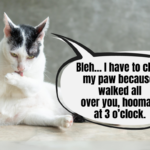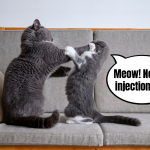Cats don’t always land on four paws. How many times before did you hear, dear fabCats, that cats know exactly how to fall safely and that even with dangerous jumps from heights they won’t have issues sticking the landing? Unfortunately, the reality doesn’t look that fly and falls are one of the major causes of serious injuries and problems with the feline musculoskeletal system. Major, but not the only one – cat surgeons, orthopedists and physiotherapists work with different patients every day, making sure they’re comfortable moving around. Today we’re checking out when a cat might experience trouble with their movements, how can we recognise it and how to introduce fitness into a cat’s life at home. Curious?
Cat injuries of bones and joints
Issues with moving around are usually a problem for cats after injuries – those living outside, after road accidents, cats who were hurt by humans or other animals, but also the domestic and indoor/outdoor cats after falls from a height or dangerous jumps. Joints and bones can get damaged during a planned jump, but also after an unplanned fall. Cats have a purrfect sense of balance and contact to the ground, but even their grace can’t win with the power of a wet and slippery window sill, a narrow rail or their inner hunting instinct.
While jumping or falling down, cats are instinctively trying to turn themselves around in the air so that they can land on their paws and cushion their body from the impact. It’s an art, but it doesn’t always work, often due to the lack of time for turning, the place of landing, badly measured distance of the fall or prior bones and joints issues that won’t allow the cat to use their full range of motion. A hard hit onto the ground (landed on four paws or not) can end with sprains, serious bone breaks and internal bleeding. The breaks will heal up with time, on their own or with the help of a surgeon, but their effects might impact the cat’s entire life afterwards.
When a cat may need physiotherapy?
Trouble with walking, painful joints, limited mobility and discomfort can appear not only in cats with injuries. Same as with hoomans, joint degeneration progresses with age and affects many senior cats. The third group of fluffy companions that might require additional support and mobility tests includes some cat breeds that are genetically predisposed to bone and joint issues. This would include big breeds (like maine coons, norwegian forest cats and syberian cats), as well as scottish folds, siamese cats or british shorthairs, to name a few.
Physiotherapy and rehabilitation within the veterinary field is mostly used as an aid for patients after serious injuries and surgeries, slowly getting back to health and a certain level of mobility. Additionally, recently it has been gaining interest among cat Guardians who understand how much of a difference it can make and how much pain relief can come for a cat working with a specialist. Cats after injuries, surgeries, accidents or with genetic or age related mobility issues are cared for by animal physiotherapists who use massage, laser treatment, magnetic field treatments, active and passive exercises, ultrasounds and hydrotherapy. A properly adjusted therapy aids and speeds up the recovery process, minimises pain and teaches the cat to trust their body once again.
How to take care of cat’s joints in a home environment?
Besides providing your cat with a safe environment and minimising the risk of falling from heights or cat-escapes, in order to take good care of the joints and the entire musculoskeletal system, it’s worth remembering that your house is your cat’s best playground. By building a cat superhighway, setting up high scratching posts that lead to shelves on the wall and allowing your cat to move around on different levels of the flat, you’re including playtime into their daily routine and improving their overall physical condition. Many domestic cats suffer from obesity, as their days are mostly filled with snacking and napping around. Without a doubt, they are two very important elements of the cat’s routine but… moving around is healthy.
Let the playtime be a part of the everyday contact and bond building between the Guardian and their cat. We know that not all furry companions are as active as bengals, who’d gladly walk on the ceiling if we let them – there are some lazy kitties, for whom playtime means swatting a feather with their paw only if it flies above their heads. Despite that we should encourage our cats to move, whether it’s with throwing them snacks to chase around, playing with a string or slowly walking around the house through shelves, cupboards and sofas. 15-30 minutes is enough for the joints to work properly and get stronger through natural movements.
Pharmacological treatment for cat’s joints
Different types of supplements and formulas that are supposed to support healthy joints and natural regeneration are getting more and more popular in the cat world. Such products can help a lot in many cat’s cases, but they should be administered carefully and after consulting it with a veterinarian. Specialists will often prescribe supplements themselves, based on the cat’s age or their RTG results, helping the cat with their rehabilitation and comeback to their regular mobility and playfulness. Supplements can be used as preventative measures as well, especially for some cat breeds or after injuries, but even then, for your and your kittie’s safety, we recommend, dear fabCats, to get a green light to use them from your veterinarian first.
Did you hear about feline physiotherapy before? Or maybe your cats have had some unpleasant injuries and mobility issues which required the help of a feline physiotherapist? We’re curious to read your stories in the comments with our morning coffee! To all cats, the young and seniors, we wish you health and injury-free lives. Stay agile and playful as long as you can.




